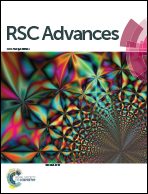Enzymatic synthesis of ibuprofen monoglycerides catalyzed by free Candida antarctica lipase B in a toluene–glycerol biphasic medium
Abstract
The enzymatic esterification of glycerol and ibuprofen in different organic media to obtain a monoester of ibuprofen was studied in an open and close system, selecting an adequate kinetic model in both cases. The solubility of ibuprofen was tested in various solvents, leading to the selection of toluene as the most appropriate organic medium. Preliminary runs led to fixing the concentration of lipase CALB-L at 2 g L−1, stirring speed at 720 rpm, a water content of 6% v/v and a glycerol to toluene volume ratio of 20/5. Kinetic runs were performed at several ibuprofen initial concentrations (20 to 100 g L−1) and temperatures (50 to 80 °C). Two systems were defined, one of which contemplated continuous removal of water with toluene. Considering kinetic and thermodynamic data, several kinetic models were proposed and fitted to all available data making use of physical and statistical criteria to select the best ones. In the first system, the chosen model was an irreversible hyperbolic model, whereas in the other system, the selected model was a Michaelis–Menten-based reversible model of pseudo-first order with respect to the concentration of ibuprofen and the monoester.


 Please wait while we load your content...
Please wait while we load your content...